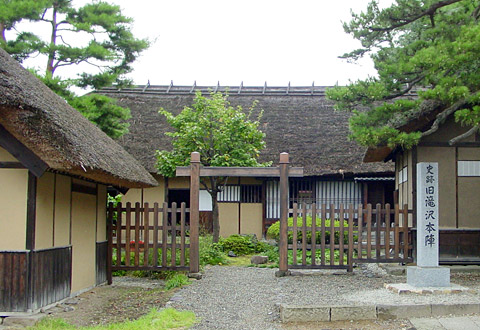|
||
 |
||
2 A type of Edo period inn found in post towns *shukubamachi 宿場町, authorized by the Tokugawa government for the reception and accommodation of travelers of high social rank including: aristocrats, kuge 公家; abbots of aristocratic or Imperial blood, monzeki 門跡; imperial messengers, chokushi 勅使; and messengers or officials of the shogun. Particularly used by barons, daimyou 大名, obliged under the rules of alternate attendance, sankin koutai 参勤交代, to divide their time between their home provinces and Edo. The structure usually consisted of a reception suite in the *shoin 書院 style, with a formal entrance porch *genkan 玄関, and often a raised room *joudan-no-ma 上段の間 as the principal chamber, equipped with a decorative alcove *tokonoma 床の間, staggered shelves *chigaidana 違い棚 and a built-in table tsukeshoin 付書院. This chamber was the living and sleeping area for the elite visitor, and often overlooked a private landscaped garden. Typically set back from the street, behind a wall with a gate, the honjin reception suite was generally appended to the house of a leading citizen (e.g. a village headman shouya 庄屋 or wholesale dealer ton'ya 問屋) of the post town. The owner was responsible for its upkeep, for feeding the visitor's entourage, and for providing facilities where the visitor's meals could be prepared, usually by the owner's own staff. Usually the same family ran the honjin for generations. Since daimyou, in particular, often traveled with a retinue numbered in hundreds or thousands, only attendants could stay in the honjin with their lord, and others were accommodated in commoners' inns *hatagoya 旅籠屋, or even in the farmhouses of surrounding villages sukegou 助郷. Large post towns might have several honjin, while smaller ones had only one. Some honjin offered shelter for the night, while others like those at Hakone 箱根 in Kanagawa prefecture, often referred to as chaya honjin 茶屋本陣, merely offered a rest and a meal. By the late Edo period, they were allowed to cater to commoners when not in official use.

Old Takizawa 滝沢 honjin 本陣 (Fukushima)
(C)2001 Japanese Architecture and Art Net Users System. No reproduction or republication without written permission.
掲載のテキスト・写真・イラストなど、全てのコンテンツの無断複製・転載を禁じます。

